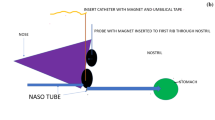Abstract
During a 16-year period, 60 neonates with gastroschisis were treated at the Department of Pediatric Surgery in Graz; 6 died and 54 (90%) survived. A questionnaire was sent to 45 patients, who were called for a medical examination; 31 patients (69%) came to follow-up, 26 of whom reported minor abdominal problems that could be related to gastroesophageal reflux (GER). Fifteen agreed to 24-h esophageal pH monitoring and/or upper gastrointestinal series; in 7 pathological GER could be demonstrated. Manometric studies in 6 patients revealed a motility disorder of the esophagus. Only 4 children were concerned by a disfiguring scar or the absence of a navel. Heigtt and weight were within normal limits and the children had developed normally.
Similar content being viewed by others
References
Arana J, Tovar JA (1989) Motor efficiency of the refluxing esophagus in basal conditions and after acid challenge. J Pediatr Surg 24: 1049–1054
Bäck M, Klos I, Flanyek A, Kurz R, Sauer H (1990) Die Entwicklung von Kindern nach Gastroschisis unter besonderer Berücksichtigung psychosozialer Aspekte. Sozialpäd Prax Klin 12: 102–108
Boix-Ochoa J, Lafuente JM, Gil-Vernet JM (1980) Twenty-four hour esophageal pH monitoring in gastroesophageal reflux. J Pediatr Surg 15: 74–78
Castell DO (1985) Introduction to pathophysiology of gastroesophageal reflux. In: Castell DO, Wu WC, Ott JD (eds) Gastroesophageal reflux disease: pathogenesis, diagnosis, therapy. Futura Publishing, New York, pp 3–9
Fass R, Sampliner RE (1994) Barrett's esophagus and other mucosal evidence of reflux in asymptomatic subjects with abnormal 24-hour esophageal pH monitoring. Dig Dis Sci 39: 423–425
Fasching G, Mayr J, Sauer H (1994) The effect of route of delivery on outcome in fetuses with gastroschisis. Pediatr Surg Int 11: 100–102
Fotter R, Höllwarth M (1981) Wassersiphontest and gastreoesophagealer Reflux im Kindersalter. Fortschr Röntgenstr 135: 53–56
Fotter R, Höllwarth M, Uray E (1985) Correlation between manometric and roentgenologic findings of diseases of the esophagus in infants and children. Progr Pediatr Surg: 14–21
Hampton FJ, MacFadyen UM, Simpson H (1990) Reproducibility of 24 hour esophageal pH studies in infants. Arch Dis Child 65: 1249–1254
Hebra A, Hoffman MA (1993) Gastroesophageal reflux in children. Pediatr Clin North Am 40: 1233–1251
Höllwarth ME, Uray E, Pesendorfer P, Rosaneli K, Rosegger H (1986) Esophageal manometry. Pediatr Surg Int 1: 177–183
Johnson IF, DeMeester TR (1986) Development of the 24-hour intraesophageal pH monitoring composite scoring system. J Clin Gastroenterol 8 [Suppl 1]: 52–58
Larsson LT, Kullendorff CM (1990) Late surgical problems in children born with abdominal wall defects. Ann Chir Gynecol 79: 23–25
Lindham S (1984) Long-term results in children with omphalocele and gastroschisis — a follow-up study. Eur J Pediatr Surg 39: 164–167
Moore TC, Nur K (1987) An international survey of gastroschisis and omphalocele (490 cases) III. Factors influencing outcome of surgical management. Pediatr Surg Int 2: 27–32
Muraji T, Tsugawa C, Nishijima E, Tanano H, Matsumoto Y, Kimura K (1989) Gastroschisis: a 17-year experience. J Pediatr Surg 24: 343–345
Novotny DA, Klein RL, Boeckman CR (1992) Gastroschisis: an 18-year review. J Pediatr Surg 28: 650–652
Schmittenbecher PP (1990) Die postoperative Kontrolle der Kardiafunktion Neugeborener nach Ösophagus-, Zwerchfell- und Bauchwandfehlbildungen. Eur J Pediatr Surg 45: 278–281
Sorantin E, Fotter R, Hausegger KA, Uray E, Schmidt B (1989) Korrelation radiologischer Befunde mit Manometrie und pH-Metrie. In: Sauer H, Haberlik A (eds) South-East-European Symposium of Pediatric Surgery, Milupa, Graz, pp 63–65
Swartz KR, Harrison MW, Campbell JR, Campbell TJ (1986) Long-term follow-up of patients with gastroschisis. Am J Surg 151: 546–549
Thompson JK, Koehler RE, Richter JE (1994) Detection of gastroesophageal reflux: value of barium studies compared with 24-hr pH monitoring. AJR Am J Roentgenol 162: 621–626
Vandenplas Y (1992) Esophageal pH monitoring: hardware and software. In: Vandenplas Y (ed) Esophageal monitoring for gastroesophageal reflux in infants and children. Wiley & Sons, Chichester New York Brisbane Toronto Singapore, pp 67–100
Author information
Authors and Affiliations
Rights and permissions
About this article
Cite this article
Fasching, G., Huber, A., Uray, E. et al. Late follow-up in patients with gastroschisis. Pediatr Surg Int 11, 103–106 (1996). https://doi.org/10.1007/BF00183736
Published:
Issue Date:
DOI: https://doi.org/10.1007/BF00183736




